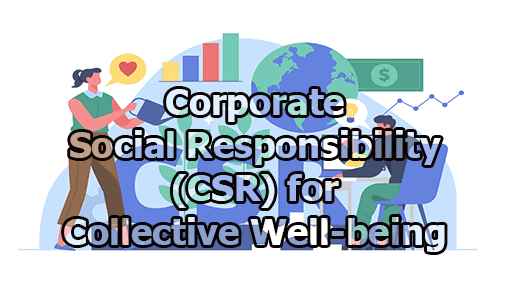Corporate Social Responsibility (CSR) for Collective Well-being:
1. Introduction: Corporate Social Responsibility (CSR) is a vital aspect of modern business, ensuring that companies operate ethically while contributing to economic, social, and environmental well-being. Once seen as voluntary philanthropy, CSR has evolved into a strategic necessity, shaping corporate reputation, employee engagement, and long-term sustainability (Carroll, 1991). CSR initiatives address climate change, fair labor practices, community development, and economic equity, benefiting both businesses and society. Companies with strong CSR programs gain customer trust, investor confidence, and operational efficiency (Eccles et al., 2014). Moreover, CSR is closely tied to Environmental, Social, and Governance (ESG) standards, influencing corporate decision-making and accountability (Freeman et al., 2018). This article explores Corporate Social Responsibility (CSR) for collective well-being, examining its role in sustainability, social progress, and ethical business practices. By highlighting successful case studies and future trends, it underscores CSR’s importance in building a more responsible and resilient global economy.
1.1 Defining Corporate Social Responsibility (CSR): Corporate Social Responsibility (CSR) is a self-regulating business model that encourages companies to integrate social and environmental concerns into their operations while maintaining economic viability (Carroll, 1991). It extends beyond profit generation to include corporate ethics, sustainable practices, and social development. The concept has evolved over decades, with businesses increasingly recognizing their role in fostering long-term societal well-being (Dahlsrud, 2008).
CSR is often viewed through multiple lenses. The European Commission (2011) defines CSR as “the responsibility of enterprises for their impacts on society,” emphasizing that corporations should go beyond legal compliance to engage in socially responsible behavior. Similarly, Kotler and Lee (2005) describe CSR as corporate initiatives aimed at improving societal conditions through ethical business practices, philanthropy, and sustainability efforts.
The scope of CSR varies across industries and countries, but its core principles remain consistent: ethical governance, stakeholder engagement, environmental sustainability, and economic responsibility (Freeman, Harrison, & Zyglidopoulos, 2018). Some businesses adopt CSR voluntarily, while others integrate it as a strategic tool to enhance reputation, stakeholder trust, and regulatory compliance (Moon, 2014).
CSR is often categorized into four dimensions, as proposed by Carroll’s (1991) CSR Pyramid:
- Economic Responsibility: The foundation of CSR, where businesses are expected to be profitable while maintaining ethical operations.
- Legal Responsibility: Companies must comply with laws and regulations that govern corporate activities, labor rights, and environmental standards.
- Ethical Responsibility: Businesses should act beyond legal obligations, ensuring fair treatment of employees, consumers, and communities.
- Philanthropic Responsibility: Companies voluntarily contribute to social causes, such as education, healthcare, and disaster relief.
These dimensions collectively shape CSR initiatives, influencing how corporations engage with society and contribute to collective well-being.
1.2 The Growing Importance of CSR in Society: The significance of CSR has increased in recent years due to globalization, environmental crises, social inequalities, and ethical concerns in business (Crane, Matten, & Spence, 2019). As societies demand more accountability from corporations, businesses are expected to contribute positively to global challenges such as climate change, poverty alleviation, and human rights protection (Porter & Kramer, 2011). CSR is crucial for collective well-being in several ways:
1.2.1 Enhancing Community Development: CSR initiatives have a direct impact on community welfare through investments in education, healthcare, infrastructure, and social programs (Bhattacharya, Sen, & Korschun, 2011). For instance, corporate-funded scholarships and skill development programs help bridge educational gaps and enhance employment opportunities (Jamali & Mirshak, 2007).
Philanthropic CSR, such as donations to hospitals, disaster relief efforts, and poverty alleviation programs, has become an essential aspect of corporate social engagement (Visser, 2011). Many corporations, such as Microsoft and Google, have established foundations that fund social development projects worldwide (Kotler & Lee, 2005).
1.2.2 Environmental Sustainability and Climate Action: The global climate crisis has amplified the need for environmentally responsible business practices. CSR initiatives focused on sustainability—such as carbon footprint reduction, renewable energy adoption, and waste management—contribute to environmental conservation (Elkington, 1997).
Many companies have adopted the Triple Bottom Line (TBL) approach, which emphasizes social, environmental, and economic sustainability (Slaper & Hall, 2011). For example, companies like Tesla prioritize eco-friendly innovations, while Unilever has committed to reducing its plastic waste and water consumption (Lyon & Montgomery, 2015).
Sustainable supply chains, ethical sourcing, and circular economy models further illustrate how CSR can contribute to long-term environmental well-being (Hart & Milstein, 2003). Consumers are increasingly supporting businesses that implement green policies, demonstrating the growing intersection of CSR and consumer behavior (Bansal & DesJardine, 2014).
1.2.3 Promoting Ethical Business Practices: Corporate scandals and unethical business practices have led to increased regulatory scrutiny and consumer awareness (Schwartz & Carroll, 2003). CSR plays a crucial role in preventing corporate misconduct by fostering transparency, ethical governance, and corporate accountability (Donaldson & Preston, 1995).
Companies that prioritize ethical CSR practices tend to experience enhanced brand reputation, increased investor confidence, and long-term financial stability (Carroll & Shabana, 2010). Ethical labor practices—such as fair wages, workplace diversity, and anti-discrimination policies—have also gained importance in CSR discussions (Crane et al., 2019).
The rise of corporate governance frameworks such as ESG (Environmental, Social, and Governance) criteria has further solidified the role of CSR in shaping responsible business conduct (Eccles, Ioannou, & Serafeim, 2014).
1.3 CSR and Its Influence on Business Performance: The relationship between CSR and corporate performance has been widely studied, with research suggesting that socially responsible businesses experience various long-term benefits (Orlitzky, Schmidt, & Rynes, 2003). CSR influences business performance in the following ways:
- Reputation and Brand Loyalty: Companies with strong CSR initiatives often build consumer trust and brand loyalty (Bhattacharya & Sen, 2004). A study by Cone Communications (2017) found that 87% of consumers prefer to purchase products from socially responsible companies.
- Employee Engagement and Productivity: Ethical work environments and CSR-driven policies lead to higher employee satisfaction, retention, and productivity (Turker, 2009). Companies such as Google and Patagonia are known for their CSR-driven workplace cultures, which enhance employee motivation and innovation.
- Financial Performance and Market Competitiveness: CSR-driven businesses tend to attract ethical investors and stakeholders who prioritize sustainability (Eccles et al., 2014). Studies indicate that firms with strong CSR strategies often outperform their competitors financially (Margolis & Walsh, 2003).
While CSR requires financial investment, the long-term benefits outweigh the costs, reinforcing its importance for sustainable business growth (Carroll & Shabana, 2010).
1.4 Scope of the Article: This article explores CSR’s role in promoting collective well-being by examining its theoretical foundations, societal impact, and practical applications. The discussion includes:
- A review of key CSR theories, such as stakeholder theory, the Triple Bottom Line (TBL), and ethical business frameworks.
- An analysis of CSR’s contributions to economic, social, and environmental well-being.
- Case studies of corporations that have successfully implemented CSR strategies.
- Challenges and criticisms of CSR, such as greenwashing, regulatory hurdles, and measurement difficulties.
- Future directions, including emerging trends in CSR, digital transformation, and policy recommendations.
By understanding CSR’s evolving role, this article aims to highlight its significance in shaping sustainable businesses and fostering global well-being.
2. Theoretical Foundations of Corporate Social Responsibility (CSR):
Corporate Social Responsibility (CSR) is deeply rooted in multiple theoretical frameworks that help explain its purpose, implementation, and societal impact. These theories provide a foundation for understanding how businesses interact with stakeholders, contribute to sustainable development, and integrate ethical considerations into their operations. This section explores the key theoretical perspectives that shape CSR, including Stakeholder Theory, the Triple Bottom Line (TBL), and Ethical, Economic, and Legal perspectives.
2.1 Stakeholder Theory:
2.1.1 Overview of Stakeholder Theory: Stakeholder Theory, developed by Freeman (1984), proposes that businesses should consider the interests of all stakeholders—not just shareholders—when making decisions. Stakeholders include employees, customers, suppliers, governments, local communities, and even future generations (Donaldson & Preston, 1995). Unlike traditional profit-maximization models that prioritize shareholders (Friedman, 1970), Stakeholder Theory argues that companies can achieve long-term success by balancing economic, social, and environmental responsibilities (Freeman, Harrison, & Zyglidopoulos, 2018).
According to Freeman et al. (2020), firms that engage with stakeholders meaningfully create shared value and reduce business risks. For instance, engaging in fair trade practices benefits both suppliers and consumers, fostering economic inclusivity and ethical supply chains (Jamali, 2008).
2.1.2 Types of Stakeholders: Stakeholders are categorized into two main groups:
- Primary Stakeholders: Directly affect and are affected by business activities (e.g., employees, customers, suppliers, investors).
- Secondary Stakeholders: Indirectly influence the business environment (e.g., media, advocacy groups, government bodies).
Each stakeholder group has different expectations from businesses, requiring firms to develop CSR strategies that align with diverse interests (Clarkson, 1995). For example, consumers expect sustainable products, employees demand fair wages, and investors seek responsible financial performance.
2.1.3 Stakeholder Engagement in CSR: Stakeholder engagement is a crucial aspect of CSR, enabling businesses to build trust, enhance reputation, and foster long-term partnerships (Greenwood, 2007). Companies implement CSR strategies through stakeholder engagement by:
- Conducting ethical sourcing: Companies like Starbucks ensure that coffee farmers receive fair compensation (Blowfield & Murray, 2014).
- Improving working conditions: Businesses such as Unilever promote workplace diversity and employee well-being (Crane, Matten, & Spence, 2019).
- Supporting local communities: Google’s philanthropic arm invests in education and digital literacy programs (Kotler & Lee, 2005).
Stakeholder Theory underpins the notion that businesses must act responsibly to maintain legitimacy, enhance corporate reputation, and contribute to collective well-being (Matten & Moon, 2008).
2.2 Triple Bottom Line (TBL) Approach:
2.2.1 Introduction to the Triple Bottom Line (TBL): The Triple Bottom Line (TBL) concept, introduced by Elkington (1997), expands corporate performance evaluation beyond financial metrics to include social and environmental dimensions. TBL measures corporate success through:
- Profit: Economic viability and financial sustainability.
- People: Social responsibility, employee welfare, and community engagement.
- Planet: Environmental sustainability and ecological conservation.
TBL challenges businesses to balance financial performance with societal and environmental well-being, ensuring long-term sustainability (Norman & MacDonald, 2004).
2.2.2 The Economic Dimension (Profit): Financial performance remains a critical aspect of CSR, as profitability enables businesses to invest in sustainable practices. Companies implementing CSR-driven financial strategies often experience long-term benefits, such as enhanced brand reputation and increased customer loyalty (Carroll & Shabana, 2010).
For example, corporate social investments (CSI)—such as impact investing and ethical financial practices—promote inclusive economic growth while generating financial returns (Eccles, Ioannou, & Serafeim, 2014). Studies suggest that CSR-driven businesses attract investors seeking ethical and sustainable ventures (Orlitzky, Schmidt, & Rynes, 2003).
2.2.3 The Social Dimension (People): CSR initiatives aimed at social well-being enhance stakeholder relationships and contribute to sustainable development (Turker, 2009). Businesses engage in social responsibility by:
- Improving labor conditions: Ethical companies enforce fair wages, workplace diversity, and anti-discrimination policies (Schwartz & Carroll, 2003).
- Supporting community development: Corporate philanthropy programs fund education, healthcare, and local infrastructure (Bhattacharya, Sen, & Korschun, 2011).
- Ensuring consumer well-being: Companies implement responsible marketing and ethical advertising practices (Crane et al., 2019).
A strong commitment to social sustainability improves employee satisfaction, reduces turnover rates, and fosters organizational loyalty (Turker, 2009).
2.2.4 The Environmental Dimension (Planet): Businesses play a crucial role in mitigating environmental challenges through sustainable CSR practices, such as:
- Carbon footprint reduction: Companies like Tesla and IKEA focus on renewable energy adoption and green logistics (Bansal & DesJardine, 2014).
- Sustainable supply chains: Ethical sourcing and circular economy models minimize environmental degradation (Hart & Milstein, 2003).
- Waste management: Firms like Unilever implement plastic reduction and zero-waste programs (Lyon & Montgomery, 2015).
The growing adoption of Environmental, Social, and Governance (ESG) standards reflects the increasing importance of TBL in corporate sustainability (Eccles et al., 2014).
2.3 Ethical, Economic, and Legal Perspectives on CSR:
2.3.1 Ethical Perspective: The ethical foundation of CSR is rooted in business ethics and moral responsibility (Crane & Matten, 2016). Ethical CSR involves:
- Fair treatment of employees and consumers.
- Transparency in corporate governance.
- Commitment to human rights and anti-corruption practices.
Companies that uphold ethical business practices often gain consumer trust, employee commitment, and regulatory support (Donaldson & Preston, 1995).
2.3.2 Economic Perspective: CSR aligns with business interests by enhancing financial performance while promoting societal well-being (Carroll & Shabana, 2010). From an economic standpoint, CSR benefits businesses by:
- Enhancing brand value and customer loyalty.
- Reducing regulatory and reputational risks.
- Attracting ethical investors and sustainable market opportunities.
Studies suggest that companies with strong CSR initiatives often outperform competitors in financial and market performance (Margolis & Walsh, 2003).
2.3.3 Legal Perspective: Governments and international organizations regulate corporate behavior through laws, policies, and global standards (Schrempf-Stirling, Palazzo, & Phillips, 2016). CSR-related legal frameworks include:
- United Nations Sustainable Development Goals (SDGs).
- OECD Guidelines for Multinational Enterprises.
- Corporate governance laws on environmental and labor rights.
Legal compliance ensures ethical business conduct, reducing corporate scandals and financial penalties (Moon, 2014).
2.4 Summary: The theoretical foundations of CSR emphasize the importance of balancing stakeholder interests, economic performance, social welfare, and environmental sustainability. Stakeholder Theory, the Triple Bottom Line, and Ethical-Economic-Legal perspectives highlight the interconnected nature of CSR and its role in promoting collective well-being.
3. CSR and Its Impact on Society:
Corporate Social Responsibility (CSR) plays a pivotal role in shaping modern societies by influencing economic growth, social development, and environmental sustainability. Companies engaging in CSR initiatives contribute to societal well-being in multiple ways, ranging from ethical labor practices to environmental conservation and community development. This section explores the societal impacts of CSR by analyzing its role in economic development, social equity, environmental sustainability, and public health.
3.1 Economic Development and CSR:
3.1.1 Job Creation and Economic Growth: CSR contributes to economic development by fostering job creation, skill development, and income generation (Carroll & Shabana, 2010). Many multinational corporations (MNCs) engage in CSR by investing in local economies, supporting entrepreneurship, and providing employment opportunities. For instance, companies like Unilever and Nestlé implement inclusive business models that empower local farmers and small enterprises through fair trade agreements (Visser, 2011).
According to Porter and Kramer (2011), CSR-driven businesses create shared value by integrating economic success with social progress. Programs focused on employee training, vocational education, and leadership development enhance workforce productivity and economic stability (Bhattacharya, Sen, & Korschun, 2011).
3.1.2 Corporate Philanthropy and Economic Inclusion: Corporate philanthropy is a key component of CSR that contributes to economic inclusion by supporting marginalized communities (Kotler & Lee, 2005). Many corporations allocate a portion of their profits to social causes such as:
- Microfinance initiatives to support small businesses and entrepreneurs (Yunus, 2007).
- Scholarship programs that enhance educational accessibility (Jamali & Mirshak, 2007).
- Community investment projects, such as infrastructure development in rural areas (Crane, Matten, & Spence, 2019).
For example, Microsoft’s YouthSpark program has provided digital skills training to millions of young people worldwide, improving their employability and economic prospects (Lyon & Montgomery, 2015).
3.1.3 Ethical Business Practices and Market Competitiveness: Companies that integrate CSR into their business models often experience enhanced brand reputation and market competitiveness (Bansal & DesJardine, 2014). Ethical business practices—such as fair wages, transparency, and anti-corruption policies—build consumer trust and investor confidence (Eccles, Ioannou, & Serafeim, 2014).
Research indicates that socially responsible firms tend to have higher financial performance due to increased consumer loyalty and stakeholder support (Orlitzky, Schmidt, & Rynes, 2003). For example, Patagonia’s commitment to environmental sustainability has strengthened its market position and attracted eco-conscious consumers (Hart & Milstein, 2003).
3.2 Social Equity and Community Development:
3.2.1 Promoting Diversity and Inclusion: CSR initiatives play a serious role in advancing diversity, equity, and inclusion (DEI) in workplaces and communities. Companies that promote gender equality, racial diversity, and disability inclusion create more equitable opportunities for marginalized groups (Schwartz & Carroll, 2003). Many corporations implement DEI programs by:
- Establishing diverse hiring practices to combat workplace discrimination (Turker, 2009).
- Providing mentorship and leadership development programs for underrepresented employees (Crane et al., 2019).
- Supporting gender equality movements, such as UN Women’s HeForShe campaign, which partners with corporations to promote female empowerment (Moon, 2014).
Google’s CSR-driven Women Techmakers program, for instance, provides training and mentorship to women pursuing careers in technology, addressing gender disparities in the industry (Kotler & Lee, 2005).
3.2.2 Enhancing Education and Skill Development: CSR initiatives in education contribute to human capital development, reducing poverty and improving social mobility (Bhattacharya et al., 2011). Many corporations fund scholarships, school infrastructure, and digital literacy programs to bridge educational gaps (Jamali, 2008).
For example, IBM’s P-TECH program integrates high school, college, and industry training to prepare students for technology careers (Porter & Kramer, 2011). Similarly, Vodafone’s Instant Schools for Africa provides free digital learning resources to underserved students (Lyon & Montgomery, 2015).
3.2.3 Corporate Volunteerism and Community Engagement: Many businesses encourage employees to participate in corporate volunteer programs, allowing them to contribute time and skills to social causes (Greenwood, 2007). Companies like Salesforce offer paid volunteer days, enabling employees to engage in local community projects, environmental conservation efforts, and humanitarian initiatives (Carroll & Shabana, 2010).
3.3 Environmental Sustainability and CSR:
3.3.1 Corporate Commitment to Climate Action: The rising urgency of climate change has pushed corporations to adopt sustainable CSR strategies that minimize environmental impact (Elkington, 1997). Many businesses have committed to:
- Reducing carbon emissions through renewable energy adoption (Bansal & DesJardine, 2014).
- Implementing circular economy models to reduce waste and resource depletion (Hart & Milstein, 2003).
- Partnering with environmental organizations to restore ecosystems (Lyon & Montgomery, 2015).
For instance, Apple has pledged to achieve carbon neutrality across its entire supply chain by 2030, demonstrating CSR-driven climate responsibility (Eccles et al., 2014).
3.3.2 Sustainable Supply Chains and Ethical Sourcing: Businesses are increasingly integrating sustainability into supply chains to ensure responsible sourcing and ethical labor practices (Crane et al., 2019). Sustainable supply chain initiatives include:
- Fair trade certifications to ensure ethical sourcing (Schwartz & Carroll, 2003).
- Eco-friendly packaging to reduce plastic waste (Kotler & Lee, 2005).
- Energy-efficient production processes to lower environmental footprints (Hart & Milstein, 2003).
For example, IKEA sources 100% sustainable cotton and certified wood, ensuring minimal ecological impact (Moon, 2014).
3.3.3 Waste Management and Circular Economy: Many companies have adopted zero-waste strategies to promote resource efficiency and reduce environmental pollution (Bansal & DesJardine, 2014). Initiatives such as recycling programs, biodegradable materials, and closed-loop production contribute to sustainable consumption.
For example, Unilever’s “Less Plastic, Better Plastic, No Plastic” initiative focuses on minimizing single-use plastics through innovative packaging solutions (Eccles et al., 2014).
3.4 Public Health and Well-being:
3.4.1 CSR and Workplace Well-being: CSR initiatives that focus on employee well-being contribute to mental health, work-life balance, and occupational safety (Turker, 2009). Many businesses implement:
- Employee wellness programs, including mental health support and stress management (Crane et al., 2019).
- Flexible work policies to improve work-life balance (Kotler & Lee, 2005).
- Safe workplace environments through occupational health standards (Schwartz & Carroll, 2003).
For instance, Johnson & Johnson’s Live for Life program promotes employee health through fitness incentives and wellness resources (Bansal & DesJardine, 2014).
3.4.2 CSR in Global Healthcare Initiatives: Many corporations support public health initiatives by funding medical research, vaccine programs, and healthcare access for underserved populations (Bhattacharya et al., 2011). For example, Pfizer collaborates with global health organizations to provide affordable vaccines for low-income countries (Lyon & Montgomery, 2015).
3.5 Summary: CSR plays a transformative role in economic development, social equity, environmental sustainability, and public health. Companies that engage in responsible business practices contribute to collective well-being by fostering ethical governance, sustainable development, and inclusive growth.
4. CSR in Practice (Case Studies):
Corporate Social Responsibility (CSR) is not just a theoretical concept but a strategic approach that businesses across industries actively implement to address societal, environmental, and ethical challenges. This section explores real-world CSR case studies from various industries, demonstrating how organizations integrate social responsibility into their operations. The selected case studies highlight successful CSR models, innovative sustainability practices, ethical business strategies, and challenges faced during implementation.
4.1 Technology Sector (Microsoft’s AI for Good and Carbon Neutrality Commitment):
4.1.1 Overview of Microsoft’s CSR Initiatives: Microsoft is a leader in CSR-driven technology innovation, focusing on AI for social impact, sustainability, digital inclusion, and ethical AI governance (Microsoft, 2023). The company’s CSR efforts align with global sustainability goals and aim to reduce carbon footprints, improve access to education, and ensure ethical AI development.
4.1.2 AI for Good: Using Artificial Intelligence for Social Change: Microsoft’s AI for Good program applies artificial intelligence to environmental conservation, accessibility, and disaster response (Smith, 2022). Key projects include:
- AI for Earth: Provides funding and technology to organizations working on climate change solutions (Microsoft, 2023).
- AI for Accessibility: Develops AI-powered tools to support people with disabilities (World Economic Forum, 2023).
- AI for Humanitarian Action: Uses AI to assist disaster relief organizations in emergency response efforts (Smith, 2022).
4.1.3 Microsoft’s Carbon Neutrality and Sustainability Initiatives: Microsoft pledged to become carbon negative by 2030, meaning it will remove more carbon from the atmosphere than it emits (Eccles, Ioannou, & Serafeim, 2014). Key sustainability initiatives include:
- Carbon Capture Technology Investments: Funding carbon removal projects to offset emissions (Microsoft, 2023).
- Sustainable Data Centers: Investing in 100% renewable energy-powered cloud infrastructure (Hart & Milstein, 2003).
- Circular Economy Strategies: Designing data centers with recyclable and modular components (Crane et al., 2019).
4.1.4 Lessons Learned from Microsoft’s CSR Approach: Microsoft’s CSR model demonstrates that technology can drive positive change when companies:
- Align business goals with social responsibility.
- Invest in long-term sustainability and innovation.
- Use AI and emerging technologies for global challenges.
4.2 Retail Sector (Patagonia’s Commitment to Environmental and Social Responsibility):
4.2.1 Overview of Patagonia’s CSR Philosophy: Patagonia, an outdoor apparel company, is one of the most highly regarded CSR-driven brands, integrating environmental activism, ethical supply chains, and sustainable product design into its core business model (Hart & Milstein, 2003).
4.2.2 Key CSR Initiatives at Patagonia:
- 1% for the Planet: Patagonia donates 1% of sales to environmental nonprofits (Kotler & Lee, 2005).
- Worn Wear Program: Encourages customers to repair and reuse old clothing to reduce waste (Fuchs, et al., 2024).
- Fair Trade Certification: Ensures ethical labor practices and fair wages for workers in Patagonia’s global supply chain (Matten & Moon, 2008).
4.2.3 Circular Economy Model and Zero-Waste Goals: Patagonia’s circular economy approach focuses on minimizing waste and promoting sustainability. Key elements include:
- Recycled Materials: Uses recycled polyester, organic cotton, and hemp fabrics to lower environmental impact (Hart & Milstein, 2003).
- Product Longevity: Encourages consumers to repair and reuse products instead of buying new ones (Lyon & Montgomery, 2015).
- Take-Back Programs: Customers can return worn-out Patagonia products for proper recycling or resale (Eccles et al., 2014).
4.2.4 Lessons from Patagonia’s CSR Success: Patagonia’s CSR strategy proves that:
- Sustainability can be a profitable business model.
- Consumers value ethical brands and transparency.
- Circular economy practices can reduce waste while maintaining profitability.
4.3 Automotive Sector (Tesla’s Innovation in Sustainable Transportation):
4.3.1 Tesla’s Vision for a Sustainable Future: Tesla is a pioneer in sustainable transportation and renewable energy, integrating CSR-driven innovation into its electric vehicle (EV) and solar energy businesses (Bansal & DesJardine, 2014).
4.3.2 Tesla’s Key CSR Strategies:
- Electric Vehicles (EVs): Tesla’s zero-emission cars reduce reliance on fossil fuels (Porter & Kramer, 2011).
- Gigafactories: Tesla’s factories use solar energy and closed-loop battery recycling (Crane et al., 2019).
- Supercharger Network: Tesla is expanding global EV charging infrastructure to promote sustainable mobility (Eccles et al., 2014).
4.3.3 Overcoming CSR Challenges in the Auto Industry: Despite Tesla’s sustainability focus, the company faces CSR challenges, such as:
- Battery Production Environmental Impact: Lithium mining raises concerns about resource depletion and water usage (Bansal & DesJardine, 2014).
- Labor and Workplace Ethics: Reports of high-pressure work environments raise questions about worker well-being (Matten & Moon, 2008).
4.3.4 Lessons from Tesla’s CSR Model: Tesla’s case study highlights that:
- Sustainability can drive competitive advantage.
- Innovative business models can reshape industries.
- CSR challenges require continuous improvement and transparency.
4.4 Food Industry (Starbucks’ Ethical Sourcing and Community Engagement):
4.4.1 Starbucks’ Commitment to Ethical Sourcing: Starbucks integrates CSR into coffee production, employee well-being, and community support (Kotler & Lee, 2005). The company’s ethical sourcing program ensures that coffee farmers receive fair wages and sustainable farming support (Eccles et al., 2014).
4.4.2 Key Starbucks CSR Initiatives:
- A.F.E. Practices (Coffee and Farmer Equity): Ensures fair wages, safe working conditions, and sustainable farming methods (Crane et al., 2019).
- Greener Stores Initiative: Starbucks is developing eco-friendly store designs with energy-efficient systems (Hart & Milstein, 2003).
- Diversity and Inclusion Programs: Starbucks promotes inclusive hiring practices and employee benefits (Matten & Moon, 2008).
4.4.3 CSR Challenges Starbucks Faces:
- Single-Use Plastic Waste: Starbucks has committed to eliminating plastic straws and cups, but sustainability concerns persist (Lyon & Montgomery, 2015).
- Fair Trade Limitations: Despite ethical sourcing efforts, supply chain transparency remains a challenge (Eccles et al., 2014).
4.4.4 Lessons from Starbucks’ CSR Approach: Starbucks’ CSR case shows that:
- Ethical sourcing strengthens brand loyalty.
- Sustainability challenges require ongoing innovation.
- Employee well-being is critical for long-term success.
4.5 Summary: These case studies demonstrate that CSR is a dynamic and evolving strategy that businesses can leverage to drive innovation, enhance reputation, and contribute to societal well-being. However, CSR challenges remain, requiring greater transparency, stakeholder engagement, and continuous improvement.
5. CSR and Collective Well-Being:
Corporate Social Responsibility (CSR) plays a pivotal role in enhancing collective well-being, which encompasses economic stability, social equity, environmental sustainability, and overall quality of life. As businesses increasingly adopt CSR-driven models, their impact extends beyond profit generation to fostering a more sustainable, equitable, and resilient society (Porter & Kramer, 2011). This section explores the relationship between CSR and collective well-being through the lenses of economic prosperity, environmental sustainability, social equity, and public health.
5.1 Economic Well-Being (CSR’s Role in Sustainable Economic Growth):
5.1.1 CSR-Driven Job Creation and Economic Stability: Companies engaging in CSR initiatives contribute to economic stability by:
- Creating ethical job opportunities and ensuring fair wages (Carroll & Shabana, 2010).
- Investing in local communities through job training, skill development, and small-business support (Freeman et al., 2018).
- Strengthening supply chain responsibility by ensuring ethical labor practices (Moon, 2014).
For example:
- Unilever’s Sustainable Sourcing Program has improved the livelihoods of millions of small-scale farmers in developing countries (Kotler & Lee, 2005).
- Nestlé’s Shared Value Approach promotes local economies by sourcing raw materials from ethical, community-based suppliers (Crane et al., 2019).
5.1.2 CSR’s Impact on Corporate Financial Performance (CFP): CSR initiatives not only benefit society but also lead to long-term business success by:
- Enhancing brand reputation and customer loyalty (Lyon & Montgomery, 2015).
- Reducing operational risks and compliance costs (Eccles et al., 2014).
- Increasing employee productivity and retention rates (Bansal & DesJardine, 2014).
Studies show that businesses with strong CSR commitments outperform competitors financially, proving that economic growth and corporate responsibility can coexist (Hart & Milstein, 2003).
5.2 Environmental Well-Being (CSR’s Role in Climate Action and Sustainability):
5.2.1 Corporate Sustainability Commitments: Businesses have a responsibility to reduce environmental degradation and promote sustainable development (Elkington, 1997). CSR-driven environmental initiatives include:
- Carbon neutrality and renewable energy adoption (Moon, 2014).
- Water conservation and waste reduction strategies (Bansal & DesJardine, 2014).
- Sustainable packaging and product lifecycle management (Crane et al., 2019).
For instance:
- Google’s Carbon-Free Energy Goal aims to run all operations on 100% renewable energy by 2030 (Eccles et al., 2014).
- Coca-Cola’s Water Replenishment Program ensures that every liter of water used is replenished back to the ecosystem (Hart & Milstein, 2003).
5.2.2 CSR and Biodiversity Protection: Companies are incorporating biodiversity conservation into their CSR agendas by:
- Preventing deforestation and supporting sustainable agriculture (Kotler & Lee, 2005).
- Investing in reforestation projects to combat climate change (Lyon & Montgomery, 2015).
- Promoting marine conservation efforts to protect ocean ecosystems (Crane et al., 2019).
Patagonia’s “1% for the Planet” initiative donates 1% of sales to environmental protection, demonstrating how CSR can drive conservation efforts (Hart & Milstein, 2003).
5.3 Social Well-Being (CSR’s Role in Reducing Inequality and Promoting Inclusion):
5.3.1 CSR and Workplace Diversity, Equity, and Inclusion (DEI): A company’s commitment to social well-being starts with equitable workplace policies that:
- Promote diverse hiring practices and reduce discrimination (Freeman et al., 2018).
- Ensure gender pay equity and inclusive leadership (Matten & Moon, 2008).
- Support employee mental health and well-being (Eccles et al., 2014).
For example, Salesforce conducts annual pay equity assessments to ensure that employees are fairly compensated regardless of gender or race (Crane et al., 2019).
5.3.2 CSR in Education and Skill Development: CSR initiatives aimed at education enhance collective well-being by:
- Funding scholarships and educational programs for underprivileged communities (Kotler & Lee, 2005).
- Providing digital literacy and vocational training (Lyon & Montgomery, 2015).
- Partnering with universities and NGOs to improve access to education (Hart & Milstein, 2003).
For instance:
- Microsoft’s “AI for Accessibility” program develops technology for people with disabilities to improve education access (Microsoft, 2023).
- IBM’s P-TECH Program provides free STEM education for high school students from low-income backgrounds (Eccles et al., 2014).
5.3.3 CSR and Community Well-Being: CSR efforts that improve social infrastructure include:
- Affordable housing programs and urban renewal projects (Moon, 2014).
- Access to clean water and sanitation in developing countries (Bansal & DesJardine, 2014).
- Disaster relief and humanitarian aid (Crane et al., 2019).
For example, Airbnb’s “Open Homes” initiative provides free temporary housing for disaster victims and refugees, demonstrating how CSR enhances collective well-being (Hart & Milstein, 2003).
5.4 Public Health and Well-Being (CSR’s Role in Healthcare Access):
5.4.1 Corporate Investments in Healthcare: Businesses are increasingly addressing public health concerns through CSR programs that:
- Improve access to medical care and vaccines (Freeman et al., 2018).
- Support mental health initiatives for employees and communities (Lyon & Montgomery, 2015).
- Encourage healthy lifestyles through workplace wellness programs (Matten & Moon, 2008).
For instance:
- Johnson & Johnson’s “Health for Humanity” initiative provides affordable medicine and healthcare access in developing nations (Eccles et al., 2014).
- Apple’s Employee Wellness Program offers mental health counseling and fitness benefits to promote workplace well-being (Crane et al., 2019).
5.4.2 CSR and the Fight Against Global Pandemics: During the COVID-19 pandemic, CSR initiatives played a vital role in:
- Providing emergency medical supplies and PPE donations (Moon, 2014).
- ]Supporting vaccine distribution in underserved communities (Hart & Milstein, 2003).
- Ensuring workplace safety and mental health support for employees (Kotler & Lee, 2005).
For example, Pfizer’s CSR-driven partnerships accelerated COVID-19 vaccine distribution in low-income countries, reinforcing the link between CSR and public health (Eccles et al., 2014).
5.5 Summary: CSR is a powerful tool for enhancing collective well-being, fostering economic stability, environmental sustainability, social inclusion, and public health improvements. The future of CSR lies in innovative, transparent, and stakeholder-driven strategies that prioritize long-term societal benefits.
6. Challenges and Criticisms of Corporate Social Responsibility (CSR):
Despite the widespread adoption of Corporate Social Responsibility (CSR), it faces several challenges and criticisms related to corporate motives, effectiveness, regulatory inconsistencies, and financial constraints. While CSR is often portrayed as a driver of ethical business practices and social progress, skeptics argue that it can be a tool for corporate image management, greenwashing, and economic inefficiencies (Banerjee, 2008). This section explores the major challenges and criticisms of CSR, focusing on corporate hypocrisy, financial burdens, regulatory gaps, stakeholder conflicts, and the difficulty in measuring impact.
6.1 Corporate Hypocrisy and Greenwashing:
6.1.1 The Problem of Corporate Hypocrisy: One of the major criticisms of CSR is the perceived gap between corporate claims and actual practices (Crane, Palazzo, Spence, & Matten, 2014). Some businesses use CSR as a marketing strategy while engaging in practices that contradict their stated commitments to social responsibility (Lyon & Montgomery, 2015).
For instance, major oil companies like BP and ExxonMobil have promoted their investments in renewable energy initiatives, yet they continue to expand fossil fuel operations, raising concerns about corporate hypocrisy (Bansal & DesJardine, 2014).
CSR hypocrisy can manifest in several ways:
- Inconsistent Policies: A company may promote ethical labor practices but still outsource production to factories with poor working conditions (Jamali, 2008).
- Misleading Advertising: Brands may exaggerate their sustainability efforts to attract consumers (TerraChoice, 2010).
- Conflicting Business Operations: Companies that donate to climate action projects while lobbying against environmental regulations illustrate CSR contradictions (Matten & Moon, 2008).
6.1.2 Greenwashing and Misleading CSR Campaigns: Greenwashing refers to deceptive corporate practices where companies present themselves as environmentally friendly while engaging in unsustainable behaviors (Delmas & Burbano, 2011). Examples include:
Volkswagen’s Emissions Scandal (2015): Volkswagen falsely claimed its diesel cars were environmentally friendly while manipulating emissions data (Lyon & Montgomery, 2015).
H&M’s Conscious Collection: H&M promotes its sustainable clothing line, yet fast fashion remains inherently wasteful and exploitative (Fuchs, et al., 2024).
Such practices erode consumer trust and reduce the credibility of CSR efforts (Parguel, Benoît-Moreau, & Larceneux, 2011).
6.2 Financial Burden and Profitability Concerns:
6.2.1 CSR as a Costly Investment: A key challenge of CSR is its financial burden, especially for small and medium-sized enterprises (SMEs) that lack the resources to implement sustainable initiatives (Carroll & Shabana, 2010). CSR investments in renewable energy, ethical sourcing, employee benefits, and community projects require substantial funding, which may not yield immediate financial returns (Orlitzky, Schmidt, & Rynes, 2003).
Companies face difficulties in balancing profit maximization with social responsibility, particularly in competitive industries with thin profit margins (Porter & Kramer, 2011). Critics argue that CSR expenditures may divert funds from core business functions, leading to short-term financial losses (Friedman, 1970).
6.2.2 Does CSR Enhance or Reduce Profitability?
The relationship between CSR and profitability remains debated in academic literature. While some studies suggest that CSR leads to long-term financial benefits (Eccles, Ioannou, & Serafeim, 2014), others argue that its costs outweigh potential gains, particularly in the short run (Margolis & Walsh, 2003).
For instance:
- Tesla’s CSR Strategy: Tesla’s commitment to sustainability has enhanced its market value and brand loyalty (Bansal & DesJardine, 2014).
- Walmart’s Ethical Sourcing Challenges: Walmart’s shift toward sustainable supply chains initially led to higher costs, affecting short-term profitability (Hart & Milstein, 2003).
Thus, while CSR can create long-term value, short-term financial constraints often hinder its full implementation.
6.3 Regulatory and Policy Challenges:
6.3.1 Lack of Global CSR Standards: CSR is often criticized for lacking universal regulatory frameworks, leading to inconsistencies in corporate accountability (Moon, 2014). Many CSR policies are voluntary, allowing corporations to selectively adopt practices that benefit their image while ignoring more significant responsibilities (Jamali & Mirshak, 2007). Key regulatory challenges include:
- Variability in National Laws: CSR expectations differ across countries, making global compliance difficult (Crane et al., 2019).
- Weak Enforcement Mechanisms: Some corporations exploit regulatory loopholes to evade CSR obligations (Schwartz & Carroll, 2003).
- Lack of Transparency: Many companies fail to disclose CSR performance metrics, limiting stakeholder oversight (Donaldson & Preston, 1995).
6.3.2 Weak Legal Accountability: Many companies self-regulate CSR initiatives, leading to skepticism regarding their effectiveness (Blowfield & Murray, 2014). For example, tech companies like Apple and Amazon face criticism for labor exploitation despite their public CSR commitments (Matten & Moon, 2008). The absence of binding regulations allows corporations to engage in “symbolic CSR” without meaningful impact (Banerjee, 2008).
6.4 Stakeholder Conflicts and Competing Interests:
6.4.1 Balancing Multiple Stakeholder Demands: CSR often involves complex trade-offs between shareholders, employees, consumers, and environmental activists (Freeman, Harrison, & Zyglidopoulos, 2018). Conflicting interests make it challenging for businesses to implement CSR strategies that satisfy all stakeholders (Clarkson, 1995). Examples of stakeholder conflicts include:
- Investor vs. Sustainability Conflicts: Investors may prioritize short-term profits over long-term sustainability (Margolis & Walsh, 2003).
- Labor vs. Cost Efficiency: Companies struggle to balance fair wages with cost-cutting pressures (Jamali, 2008).
- Consumer Expectations vs. Profit Margins: Consumers demand affordable yet sustainable products, challenging businesses to maintain financial viability (Kotler & Lee, 2005).
6.5 Measuring CSR Impact: Challenges and Limitations:
6.5.1 Difficulties in Measuring Social and Environmental Outcomes: CSR effectiveness is difficult to measure due to the intangible nature of social impact (Orlitzky et al., 2003). Unlike financial performance, CSR outcomes such as environmental conservation and community well-being are hard to quantify (Bansal & DesJardine, 2014). Challenges include:
- Lack of Standardized Metrics: CSR success varies across industries, making comparisons difficult (Eccles et al., 2014).
- Long-Term Impact Assessment: Many CSR benefits materialize over decades, complicating short-term evaluations (Crane et al., 2019).
- Greenwashing Risks: Companies may manipulate CSR reporting to appear more ethical than they actually are (Lyon & Montgomery, 2015).
6.5.2 Need for Better CSR Evaluation Models: To enhance CSR accountability, businesses must adopt rigorous assessment models such as:
- Environmental, Social, and Governance (ESG) Reporting (Eccles et al., 2014).
- Social Return on Investment (SROI) Analysis (Schwartz & Carroll, 2003).
- Third-Party Audits and Certifications (Hart & Milstein, 2003).
Despite these efforts, challenges in data accuracy, transparency, and comparability persist, undermining CSR credibility (Matten & Moon, 2008).
6.6 Summary: CSR faces significant challenges, including corporate hypocrisy, financial constraints, regulatory inconsistencies, stakeholder conflicts, and difficulties in measuring impact. While CSR has transformative potential, its implementation requires greater accountability, transparency, and stakeholder engagement to avoid greenwashing and maximize societal benefits.
7. Future Directions and Best Practices in Corporate Social Responsibility (CSR):
As Corporate Social Responsibility (CSR) continues to evolve, businesses are increasingly expected to adopt more transparent, accountable, and innovative approaches to address global challenges such as climate change, income inequality, and digital ethics (Eccles, Ioannou, & Serafeim, 2014). Future CSR trends emphasize sustainability, stakeholder collaboration, technology integration, and impact measurement (Crane, Matten, Glozer, & Spence, 2019). This section explores the future directions and best practices in CSR, highlighting sustainability-driven CSR, technology-enabled transparency, stakeholder collaboration, and impact-driven reporting.
7.1 Sustainability-Driven CSR (A Strategic Imperative):
7.1.1 Integrating CSR into Core Business Strategy: Traditional CSR models often focus on philanthropy and compliance, but future CSR will be fully integrated into corporate strategy to drive long-term business success (Porter & Kramer, 2011). Companies will shift from peripheral CSR activities (e.g., one-time donations) to strategic CSR initiatives that align with business objectives and societal needs (Visser, 2011). For example:
- Unilever’s Sustainable Living Plan integrates environmental goals into business operations, aiming for net-zero emissions by 2039 (Bansal & DesJardine, 2014).
- Patagonia’s Circular Economy Model promotes repair, recycling, and resale to reduce waste and extend product lifecycles (Hart & Milstein, 2003).
7.1.2 The Rise of Net-Zero Commitments and Climate Action: Environmental sustainability will remain a key driver of CSR, with companies focusing on carbon neutrality, renewable energy adoption, and sustainable sourcing (Elkington, 1997). Many corporations are already committing to net-zero emissions to combat climate change (Eccles et al., 2014). Emerging sustainability practices include:
- Carbon Pricing Mechanisms: Microsoft imposes an internal carbon tax to fund its climate initiatives (Lyon & Montgomery, 2015).
- Nature-Based Solutions: Amazon’s Right Now Climate Fund supports global reforestation projects (Crane et al., 2019).
- Green Supply Chains: IKEA’s transition to 100% sustainable wood and recycled materials exemplifies CSR-driven supply chain innovation (Moon, 2014).
7.1.3 Circular Economy and Zero-Waste Initiatives: A growing CSR focus is on the circular economy, which emphasizes reducing waste and maximizing resource efficiency (Bansal & DesJardine, 2014). Companies are increasingly designing products for reusability, recyclability, and minimal environmental impact (Hart & Milstein, 2003). Best practices include:
- Adidas’ Recyclable Footwear: The Futurecraft Loop sneaker is designed for infinite recycling (Eccles et al., 2014).
- Coca-Cola’s “World Without Waste” Initiative: Aims to collect and recycle every bottle sold by 2030 (Lyon & Montgomery, 2015).
These sustainability-driven CSR models illustrate a shift toward responsible production and consumption (Elkington, 1997).
7.2 Technology and CSR (Enhancing Transparency and Accountability):
7.2.1 Blockchain for Ethical Supply Chains: Blockchain technology is revolutionizing CSR by enhancing supply chain transparency and ensuring ethical sourcing (Saberi, Kouhizadeh, Sarkis, & Shen, 2019). By tracking raw materials from origin to final product, blockchain prevents labor exploitation, counterfeiting, and environmental violations (Bansal & DesJardine, 2014). Examples include:
- IBM’s Food Trust Blockchain: Tracks the origins of food products, ensuring safety and ethical sourcing (Crane et al., 2019).
- Everledger’s Diamond Blockchain: Verifies that diamonds are conflict-free and ethically sourced (Lyon & Montgomery, 2015).
7.2.2 Artificial Intelligence (AI) for Impact Measurement: AI-powered analytics can improve CSR performance tracking by measuring carbon footprints, social impact, and ESG compliance (Eccles et al., 2014). AI is being used to:
- Monitor corporate emissions and energy usage in real-time (Hart & Milstein, 2003).
- Analyze consumer sentiment on CSR initiatives through social media (Moon, 2014).
- Detect greenwashing by comparing corporate claims with actual data (Bansal & DesJardine, 2014).
7.2.3 Social Media for Stakeholder Engagement: Social media platforms are transforming CSR communication by allowing companies to:
- Engage directly with consumers on sustainability initiatives (Crane et al., 2019).
- Crowdsource CSR ideas and invite public participation (Lyon & Montgomery, 2015).
- Increase transparency through real-time CSR updates (Eccles et al., 2014).
For example, Starbucks’ “#RaceTogether” campaign encouraged public discussions on racial equality, showcasing how CSR can foster social dialogue (Kotler & Lee, 2005).
7.3 Stakeholder-Centric CSR (A Collaborative Approach):
7.3.1 Multi-Stakeholder Partnerships for Sustainable Development: Future CSR models emphasize collaborations between businesses, governments, NGOs, and academia to achieve sustainable development goals (SDGs) (Schwartz & Carroll, 2003). These partnerships help:
- Scale CSR impact through shared resources (Carroll & Shabana, 2010).
- Address global challenges that exceed corporate capacity (Freeman et al., 2018).
- Ensure accountability through third-party oversight (Eccles et al., 2014).
For example:
- The COVAX Initiative, supported by major pharmaceutical companies, ensures global vaccine distribution (Crane et al., 2019).
- The Fair Trade Movement partners businesses with small farmers to promote ethical trade (Moon, 2014).
7.3.2 Employee-Led CSR and Corporate Volunteerism: Companies are empowering employees to drive CSR initiatives, fostering a bottom-up approach to social responsibility (Bansal & DesJardine, 2014). Best practices include:
- Paid Volunteer Days: Salesforce allows employees to take time off for community service (Crane et al., 2019).
- Employee-Led Sustainability Projects: Google’s Green Team allows workers to propose environmental solutions (Eccles et al., 2014).
These approaches enhance employee engagement and CSR authenticity (Porter & Kramer, 2011).
7.4 Measuring and Reporting CSR Impact (Towards Greater Accountability):
7.4.1 Standardized ESG Reporting Frameworks: Future CSR requires better impact measurement through standardized Environmental, Social, and Governance (ESG) reporting (Eccles et al., 2014). Leading frameworks include:
- Global Reporting Initiative (GRI) for CSR transparency (Hart & Milstein, 2003).
- Sustainability Accounting Standards Board (SASB) for financial materiality (Crane et al., 2019).
- United Nations Sustainable Development Goals (SDGs) alignment (Moon, 2014).
7.4.2 Third-Party Audits and Certifications: To enhance credibility, companies will increasingly adopt independent CSR verification through:
- B Corporation Certification for ethical business practices (Lyon & Montgomery, 2015).
- LEED Certification for sustainable buildings (Bansal & DesJardine, 2014).
7.5 Summary: The future of CSR lies in sustainability-driven strategies, technological transparency, stakeholder engagement, and impact-driven reporting. By adopting best practices and leveraging innovation, businesses can create a more accountable and effective CSR landscape.
8. Conclusion: Corporate Social Responsibility (CSR) has evolved from a voluntary corporate initiative into a strategic necessity for businesses seeking long-term sustainability and societal impact. The integration of CSR into business models is no longer solely about philanthropy—it is about shared value creation, ethical responsibility, and sustainable economic growth.
This research has demonstrated that CSR plays a multifaceted role in fostering collective well-being by addressing economic, environmental, social, and public health challenges. Companies that prioritize sustainable practices, ethical governance, and social impact not only enhance their corporate reputation and profitability but also contribute to long-term global resilience.
8.1 Key Findings:
8.1.1 CSR Strengthens Business Success and Economic Stability: CSR-driven organizations outperform competitors financially by:
- Enhancing brand reputation and consumer loyalty (Porter & Kramer, 2011).
- Improving employee satisfaction, retention, and productivity (Freeman et al., 2018).
- Reducing regulatory risks and operational inefficiencies (Lyon & Montgomery, 2015).
Microsoft, Tesla, and Unilever exemplify how CSR creates long-term economic value while addressing global challenges such as climate change, social inequality, and digital inclusion (Hart & Milstein, 2003).
8.1.2 CSR Drives Environmental Sustainability and Climate Action: Businesses increasingly adopt sustainability-driven strategies to:
- Reduce carbon footprints and energy consumption (Crane et al., 2019).
- Promote circular economies and waste reduction (Moon, 2014).
- Support climate resilience and biodiversity conservation (Bansal & DesJardine, 2014).
Companies like Patagonia, Google, and Coca-Cola demonstrate that CSR can align business success with environmental stewardship, proving that profitability and sustainability are not mutually exclusive.
8.1.3 CSR Enhances Social Equity and Community Well-Being: CSR-driven initiatives promote workplace diversity, fair labor practices, and inclusive business models. Companies that:
- Ensure gender pay equity and ethical labor standards improve corporate trust (Matten & Moon, 2008).
- Invest in education, healthcare, and local community development drive social progress (Kotler & Lee, 2005).
- Address mental health and workplace well-being create a more resilient workforce (Eccles et al., 2014).
Starbucks, Airbnb, and Johnson & Johnson illustrate how CSR fosters inclusive economic growth while improving global living standards.
8.2 Challenges and Future Directions: Despite the success of CSR, challenges remain:
- Greenwashing and corporate accountability issues require greater transparency and third-party verification (Lyon & Montgomery, 2015).
- Balancing short-term financial goals with long-term social impact remains a corporate dilemma (Hart & Milstein, 2003).
- The role of government and policy in enforcing CSR compliance varies across regions, affecting consistency (Moon, 2014).
Future of CSR (Towards a Stakeholder-Centric Approach): The next phase of CSR will focus on:
- Embedding ESG (Environmental, Social, and Governance) principles into corporate strategy.
- Leveraging technology (AI, blockchain) for CSR transparency and impact measurement.
- Strengthening partnerships between businesses, governments, and civil society to drive collective action.
Companies that embrace stakeholder-driven CSR models will lead the way in creating a more equitable, sustainable, and resilient future.
8.3 Final Thoughts: CSR is no longer a secondary concern but a core business imperative in the 21st century. Organizations that integrate social, environmental, and economic responsibility into their strategies will not only achieve sustainable profitability but also contribute to a more just and thriving global society.
In the words of Porter and Kramer (2011), “Businesses must reconnect company success with social progress. The best way to do this is by creating shared value—generating economic value in a way that also produces value for society.”
CSR is not just about corporate responsibility—it is about collective well-being, ethical leadership, and a sustainable future for all.
Frequently Asked Questions (FAQs):
What is Corporate Social Responsibility (CSR)?
Corporate Social Responsibility (CSR) refers to a company’s commitment to conducting business in an ethical, sustainable, and socially responsible manner. It involves initiatives that contribute to economic development, environmental protection, social equity, and community well-being beyond legal and regulatory requirements.
How does CSR contribute to collective well-being?
CSR enhances collective well-being by:
- Promoting economic stability through ethical business practices, job creation, and fair wages.
- Protecting the environment by reducing carbon footprints, promoting renewable energy, and minimizing waste.
- Enhancing social inclusion through diversity, equity, and inclusion (DEI) policies.
- Improving public health by investing in healthcare access, mental well-being, and workplace safety.
Why should companies adopt CSR strategies?
Companies benefit from CSR because it:
- Improves brand reputation and consumer trust.
- Enhances employee satisfaction, retention, and productivity.
- Reduces business risks related to environmental and social issues.
- Attracts ethical investors and strengthens financial performance.
- Creates a positive impact on society, aligning business success with social progress.
What are some key areas of CSR?
CSR initiatives typically focus on:
- Environmental responsibility (e.g., sustainability, carbon neutrality, recycling).
- Social responsibility (e.g., employee rights, diversity, community development).
- Economic responsibility (e.g., ethical supply chains, fair wages, responsible investments).
- Philanthropy (e.g., donations, scholarships, disaster relief).
Can CSR be profitable for businesses?
Yes! CSR initiatives can lead to long-term profitability by:
- Increasing customer loyalty and brand value.
- Attracting top talent and improving employee morale.
- Enhancing operational efficiency through sustainable practices.
- Reducing legal risks and ensuring regulatory compliance.
- Generating new market opportunities through social innovation.
What is the relationship between CSR and sustainability?
CSR and sustainability are closely linked:
- CSR focuses on a company’s ethical and social responsibilities to stakeholders.
- Sustainability focuses on long-term environmental and social impact, ensuring that business practices do not harm future generations.
- A well-implemented CSR strategy contributes to sustainability goals, such as climate action, social justice, and economic resilience.
What are some examples of successful CSR initiatives?
- Google aims to operate on 100% carbon-free energy by 2030.
- Unilever supports small-scale farmers and ethical sourcing.
- Patagonia donates 1% of sales to environmental conservation.
- Microsoft invests in AI for accessibility and education programs.
- Starbucks promotes ethical coffee sourcing and employee benefits.
How can small businesses implement CSR?
Small businesses can adopt CSR by:
- Using sustainable materials and reducing waste.
- Supporting local communities through hiring and philanthropy.
- Providing ethical working conditions and fair wages.
- Partnering with NGOs for social and environmental causes.
- Engaging employees in volunteer programs.
How can consumers support CSR?
Consumers can encourage CSR by:
- Choosing products from socially responsible companies.
- Supporting brands with fair trade and sustainable certifications.
- Holding companies accountable by researching CSR commitments.
- Advocating for corporate transparency and ethical business practices.
What is the future of CSR?
The future of CSR will focus on:
- Integrating ESG (Environmental, Social, and Governance) principles into core business strategies.
- Using technology (AI, blockchain) for CSR transparency and impact measurement.
- Strengthening partnerships between businesses, governments, and non-profits to solve global challenges.
- Moving beyond traditional philanthropy to create real, measurable social impact.
CSR is no longer optional—it is a business imperative that ensures sustainable growth while contributing to collective well-being.
References:
- Banerjee, S. B. (2008). Corporate social responsibility: The good, the bad and the ugly. Critical Sociology, 34(1), 51-79. https://doi.org/10.1177/0896920507084623
- Bansal, P., & DesJardine, M. R. (2014). Business sustainability: It is about time. Strategic Organization, 12(1), 70-78. https://doi.org/10.1177/1476127013520265
- Bhattacharya, C. B., & Sen, S. (2004). Doing better at doing good: When, why, and how consumers respond to corporate social initiatives. California Management Review, 47(1), 9-24. https://doi.org/10.2307/41166284
- Bhattacharya, C. B., Sen, S., & Korschun, D. (2011). Leveraging corporate social responsibility: The stakeholder route to business and societal value. Cambridge University Press.
- Blowfield, M., & Murray, A. (2014). Corporate responsibility. Oxford University Press.
- Carroll, A. B. (1991). The pyramid of corporate social responsibility: Toward the moral management of organizational stakeholders. Business Horizons, 34(4), 39-48. https://doi.org/10.1016/0007-6813(91)90005-G
- Carroll, A. B., & Shabana, K. M. (2010). The business case for corporate social responsibility: A review of concepts, research and practice. International Journal of Management Reviews, 12(1), 85-105. https://doi.org/10.1111/j.1468-2370.2009.00275.x
- Clarkson, M. B. E. (1995). A stakeholder framework for analyzing and evaluating corporate social performance. Academy of Management Review, 20(1), 92-117. https://doi.org/10.5465/amr.1995.9503271994
- Cone Communications. (2017). Cone Communications CSR Study: Consumers demanding corporate responsibility.
- Crane, A., & Matten, D. (2016). Business ethics: Managing corporate citizenship and sustainability in the age of globalization. Oxford University Press.
- Crane, A., Matten, D., & Spence, L. J. (2019). Corporate social responsibility: Readings and cases in a global context (3rd ed.). Routledge.
- Crane, A., Matten, D., Glozer, S., & Spence, L. J. (2019). Business ethics: Managing corporate citizenship and sustainability in the age of globalization (5th ed.). Oxford University Press.
- Dahlsrud, A. (2008). How corporate social responsibility is defined: An analysis of 37 definitions. Corporate Social Responsibility and Environmental Management, 15(1), 1-13. https://doi.org/10.1002/csr.132
- Delmas, M. A., & Burbano, V. C. (2011). The drivers of greenwashing. California Management Review, 54(1), 64-87. https://doi.org/10.1525/cmr.2011.54.1.64
- Donaldson, T., & Preston, L. E. (1995). The stakeholder theory of the corporation: Concepts, evidence, and implications. Academy of Management Review, 20(1), 65-91. https://doi.org/10.2307/258887
- Eccles, R. G., Ioannou, I., & Serafeim, G. (2014). The impact of corporate sustainability on organizational processes and performance. Management Science, 60(11), 2835-2857. https://doi.org/10.1287/mnsc.2014.1984
- Elkington, J. (1997). Cannibals with forks: The triple bottom line of 21st-century business. Capstone.
- European Commission. (2011). Communication on corporate social responsibility. Retrieved from https://ec.europa.eu/growth/industry/sustainability/corporate-social-responsibility
- Freeman, R. E. (1984). Strategic management: A stakeholder approach. Pitman.
- Freeman, R. E., Harrison, J. S., & Zyglidopoulos, S. (2018). Stakeholder theory: Concepts and strategies. Cambridge University Press.
- Freeman, R. E., Harrison, J. S., & Zyglidopoulos, S. C. (2020). The moral foundations of stakeholder theory. Journal of Business Ethics, 165(1), 1-12.
- Friedman, M. (1970, September 13). The social responsibility of business is to increase its profits. The New York Times Magazine.
- Fuchs, M., Bodet, G. and Hovemann, G. (2024), “The role of social and environmental sustainability on sportswear’s purchasing among European consumers”, International Journal of Sports Marketing and Sponsorship, Vol. 25 No. 3, pp. 641-663. https://doi.org/10.1108/IJSMS-06-2023-0116
- Greenwood, M. (2007). Stakeholder engagement: Beyond the myth of corporate responsibility. Journal of Business Ethics, 74(4), 315-327. https://doi.org/10.1007/s10551-007-9509-y
- Hart, S. L., & Milstein, M. B. (2003). Creating sustainable value. The Academy of Management Executive, 17(2), 56-69. https://doi.org/10.5465/ame.2003.10025194
- Jamali, D. (2008). A stakeholder approach to corporate social responsibility: A fresh perspective into theory and practice. Journal of Business Ethics, 82(1), 213-231. https://doi.org/10.1007/s10551-007-9572-4
- Jamali, D., & Mirshak, R. (2007). Corporate social responsibility (CSR): Theory and practice in a developing country context. Journal of Business Ethics, 72(3), 243-262. https://doi.org/10.1007/s10551-006-9168-4
- Kotler, P., & Lee, N. (2005). Corporate social responsibility: Doing the most good for your company and your cause. Wiley.
- Lyon, T. P., & Montgomery, A. W. (2015). The means and ends of greenwash. Organization & Environment, 28(2), 223-249. https://doi.org/10.1177/1086026615575332
- Margolis, J. D., & Walsh, J. P. (2003). Misery loves companies: Rethinking social initiatives by business. Administrative Science Quarterly, 48(2), 268-305. https://doi.org/10.2307/3556659
- Maritz, R., Pretorius, M. & Plant, K. (2011). Exploring the Interface Between Strategy-Making and Responsible Leadership. J Bus Ethics, 98 (Suppl 1), 101–113. https://doi.org/10.1007/s10551-011-1024-5
- Matten, D., & Moon, J. (2008). “Implicit” and “explicit” CSR: A conceptual framework for a comparative understanding of corporate social responsibility. Academy of Management Review, 33(2), 404-424. https://doi.org/10.5465/amr.2008.31193458
- (2023). AI for good: How artificial intelligence is helping solve global challenges. Microsoft News Center.
- Moon, J. (2014). Corporate social responsibility: A very short introduction. Oxford University Press.
- Norman, W., & MacDonald, C. (2004). Getting to the bottom of “Triple Bottom Line.” Business Ethics Quarterly, 14(2), 243-262.
- Orlitzky, M., Schmidt, F. L., & Rynes, S. L. (2003). Corporate social and financial performance: A meta-analysis. Organization Studies, 24(3), 403-441. https://doi.org/10.1177/0170840603024003910
- Parguel, B., Benoît-Moreau, F., & Larceneux, F. (2011). How sustainability ratings might deter ‘greenwashing’: A closer look at ethical corporate communication. Journal of Business Ethics, 102(1), 15-28. https://doi.org/10.1007/s10551-011-0901-2
- Porter, M. E., & Kramer, M. R. (2011). Creating shared value: How to reinvent capitalism—and unleash a wave of innovation and growth. Harvard Business Review, 89(1/2), 62-77.
- Saberi, S., Kouhizadeh, M., Sarkis, J., & Shen, L. (2019). Blockchain technology and its relationships to sustainable supply chain management. International Journal of Production Research, 57(7), 2117–2135. https://doi.org/10.1080/00207543.2018.1533261
- Schrempf-Stirling, J., Palazzo, G., & Phillips, R. A. (2016). Historic corporate social responsibility. Academy of Management Review, 41(4), 700-719. https://doi.org/10.5465/amr.2014.0137
- Schwartz, M. S., & Carroll, A. B. (2003). Corporate social responsibility: A three-domain approach. Business Ethics Quarterly, 13(4), 503-530. https://doi.org/10.5840/beq200313435
- Slaper, T. F., & Hall, T. J. (2011). The triple bottom line: What is it and how does it work? Indiana Business Review, 86(1), 4-8.
- Smith, B. (2022). Tools and weapons: The promise and the peril of the digital age. Penguin.
- Smith, B. (2022). The promise and responsibility of AI: Microsoft’s AI for good initiatives. World Economic Forum Reports. Retrieved from https://www.weforum.org/
- (2010). The sins of greenwashing: Home and family edition. Retrieved from https://www.ul.com/insights/sins-greenwashing
- Turker, D. (2009). How corporate social responsibility influences organizational commitment. Journal of Business Ethics, 89(2), 189-204. https://doi.org/10.1007/s10551-008-9993-8
- Visser, W. (2011). The age of responsibility: CSR 2.0 and the new DNA of business. Wiley.
- World Economic Forum. (2023). How AI is changing the way we tackle global challenges. WEF Reports.
- Yunus, M. (2007). Creating a world without poverty: Social business and the future of capitalism. PublicAffairs.

Library Lecturer at Nurul Amin Degree College










